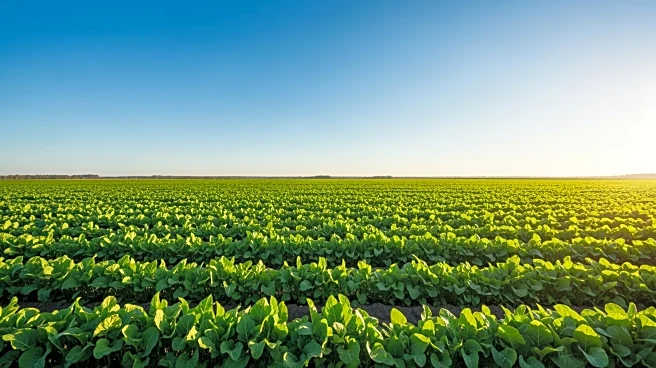What's Happening?
The adoption of cover crops among U.S. farmers has shown stability over the past five years, according to data from the Purdue University-CME Group Ag Economy Barometer surveys. These surveys, conducted
monthly, assess producer sentiment and periodically include questions on production practices such as cover crops. The surveys reveal that cover crops were planted on 4.7% of total U.S. cropland in 2022, with a slightly higher adoption rate of 5.1% in Iowa, Illinois, and Indiana. Despite the stable adoption rates, the experience and intensity of cover crop use have expanded, with 53% of survey respondents currently using cover crops. The surveys also highlight motivations for planting cover crops, such as improving soil health and erosion control, which are cited by approximately one-third of respondents.
Why It's Important?
Cover crops play a crucial role in sustainable agriculture by improving soil health, controlling erosion, and enhancing water quality. The stable adoption rates indicate a consistent interest among farmers in conservation practices, which can lead to long-term benefits for the agricultural sector. However, the surveys also point out barriers to broader adoption, such as profitability concerns and potential negative impacts on crop yields. Understanding these challenges is essential for policymakers and agricultural stakeholders to develop effective incentive programs and support systems that encourage wider adoption of cover crops. The findings from the Ag Economy Barometer surveys provide valuable insights into the factors influencing farmers' decisions and the potential for expanding sustainable practices in U.S. agriculture.
What's Next?
Continued monitoring of cover crop adoption trends will be important to assess the impact of economic conditions, incentive programs, and agronomic outcomes on the sustainability of cover crop use. Stakeholders may need to address profitability concerns and yield impacts to encourage broader adoption. Future surveys and research could focus on identifying effective strategies to overcome these barriers and promote the benefits of cover crops. Additionally, policymakers might consider enhancing incentive programs to support farmers in adopting conservation practices, thereby contributing to the long-term sustainability of the agricultural sector.
Beyond the Headlines
The adoption of cover crops is not only a matter of agricultural practice but also involves ethical and environmental considerations. As farmers increasingly recognize the benefits of cover crops for soil health and erosion control, there is potential for a cultural shift towards more sustainable farming practices. This shift could lead to improved environmental outcomes, such as reduced soil degradation and enhanced biodiversity. Furthermore, the expansion of cover crop use may influence public policy discussions on sustainable agriculture and climate change mitigation, highlighting the interconnectedness of agricultural practices and broader environmental goals.












